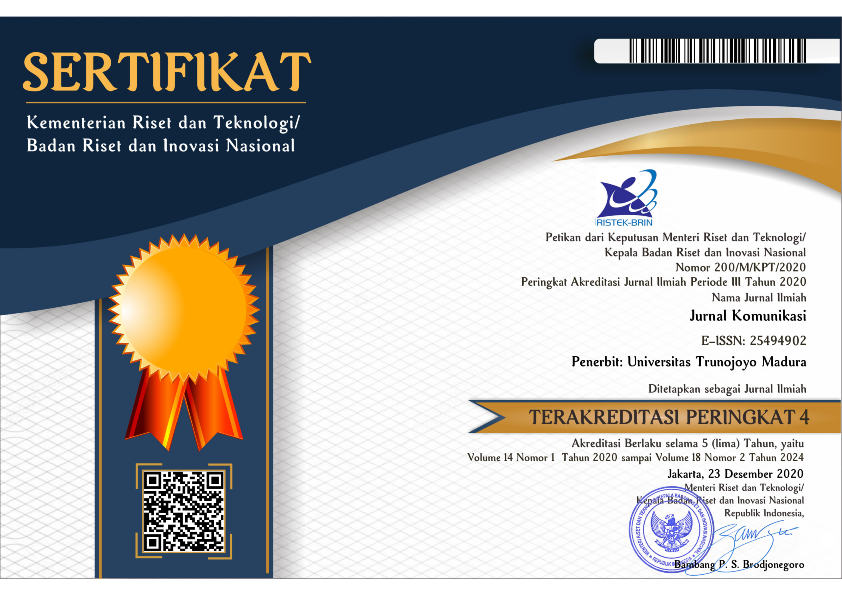Satire Journalism: Semiotic Analysis of Pilpres 2024 Articles on Mojok.co"
Abstract
This study aims to analyze the practice of satire journalism in Mojok.co through Charles S. Peirce's semiotic approach. The research method used is descriptive qualitative research. This research focuses on analyzing articles about the 2024 presidential election published in the essay section of Mojok.co. In this study, researchers explored how satire in this context uses signs and symbolic interpretations based on the semiotic theory applied. In addition, the researcher is also interested in knowing how the use of satire language style can affect readers' perceptions and understanding of the political issues presented. The results of this study conclude that Mojok.co sometimes violates the journalistic code of ethics in presenting satire content. This can reduce the integrity of journalism and lead to misunderstanding of the subject being criticized. However, this study also found that Mojok.co has the power to attract readers and raise political issues through its satire style. This research provides insight into how media can shape audience understanding and interpretation through the use of signs, objects and interpretants in the practice of satire journalism.
Keywords
Full Text:
PDFReferences
Amir, A. K., Lailiyah, F., & Ningsih, M. (2021). ANALISIS SEMIOTIKA DARK JOKE DAN SATIRE COKI PARDEDE DI MEDIA SOSIAL INSTAGRAM. PAWITRA KOMUNIKA: Jurnal Komunikasi Dan Sosial Humaniora, 2(2), 180–193.
Badudu, Y. S. (1993). Cakrawala bahasa Indonesia. Gramedia Pustaka Utama.
Berger, P. L. (2014). Redeeming laughter: The comic dimension of human experience. Walter de Gruyter GmbH & Co KG.
Fajar, Y. S. (2022). FENOMENA BAHASA SATIRE DALAM MEME DI MEDIA SOSIAL. Sinar Dunia: Jurnal Riset Sosial Humaniora Dan Ilmu Pendidikan, 1(4), 52–61.
Fiske, J. (2010). Cultural and Communication Studies-sebuah Pengantar Paling Komprehensif.
Irvine, M. (1998). Global cyberculture reconsidered: cyberspace, identity, and the global informational city. Paper Originally Delivered at INET.
Karomatunisa, D. (2017). Semiotika Korupsi Dalam Lirik Lagu “Rekening Gendut” Karya Iwan Fals. Fakultas Ilmu Dakwah dan Ilmu Komunikasi Universitas Islam Negeri Syarif.
Nurhidayat, K. K. (2016). Analisis Gaya Bahasa Satire Dan Pesan Pada Rubrik Lincak Surat Kabar Harian Solopos. Skripsi. Surakarta: Fakultas Keguruaan Dan Ilmu Pendidikan, Universitas Muhammadiyah Surakarta.
Nuryanah, Y. (2017). Satir dalam Kumpulan Cerpen Kuda Terbang Maria Pinto Karya Linda Christanty dan Implikasinya Terhadap Pembelajaran Bahasa dan Sastra Indonesia.
Sritika, I. (2019). CITRA MEDIA BERDASARKAN PENGGUNAAN GAYA BAHASA PADA RUBRIK ESAI DALAM MOJOK. CO (Sebuah Kajian Semiotika MAK Halliday). Universitas Diponegoro.
Suciartini, N. N. A. (2019). ANALISIS BAHASA SATIRE DALAM PERTARUNGAN POLITIK 2019 (Satire Language Analysis in Political 2019). Sirok Bastra, 7(1), 73–84.
Utomo, W. P. (2015). Menertawakan politik: anak muda, satire dan parodi dalam situs mojok. co. Jurnal Studi Pemuda, 4(1), 190–205.
Yulianti, N. (2019). Satire Sebagai Praktik Jurnalisme Komedi (Analisis Semiotik Artikel Berlabel# 2019gantipresiden Pada Mojok. Co). Fakultas Ilmu Dakwah dan Ilmu Komunikasi Universitas Islam Negeri Syarif .
DOI: https://doi.org/10.21107/ilkom.v17i2.20818
Refbacks
- There are currently no refbacks.
Copyright (c) 2023 Rosdiana Rosdiana

This work is licensed under a Creative Commons Attribution-ShareAlike 4.0 International License.
Jurnal Komunikasi by Universitas Trunojoyo Madura is licensed under a Creative Commons Attribution-ShareAlike 4.0 International License.















